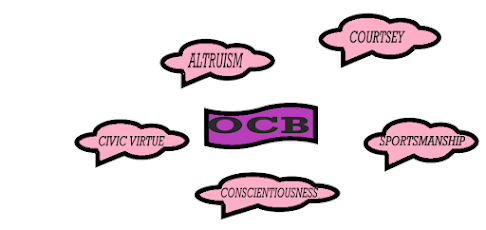The field of Organizational Behavior is evolving everyday. Researches are being conducted to explore new arenas of OB. There are already several concepts, theories and models which are been applied to study and promote human behavior in the area of Industries and Organizations.
The popular phrases "going above and beyond" or "giving their all" are almost getting zero application in the human life. We are restricting our behavior within the stipulated boundaries and scaling them with the job role which has been assigned to us by the organization.
The modern era concept of Organization Citizenship Behavior (OCB) is reaching out the field of OB quite prominently. The OCB if explained in simple languages, is the response or actions or behaviors which are not required by the personnel. They are not a job characteristics, but are beneficial to the team and works for the organization's better functioning and efficiency.
OCB has been defined as, "individual behavior that is discretionary, not directly or explicitly recognized by the formal reward system, and in the aggregate promotes the efficient functioning of the organization". (Organ, 1997)
BENEFITS OF PRACTICING OCB:
1) Finding one's work meaningful. The workers feel more significant and their contribution to the workplace more essential and useful.
2) Organization Citizenship Behavior increase the control ability over one's own tasks. They have a greater grip on what they are performing or how they are performing.
3) This kind of behavior helps in preventing burnout. As, the personnel identifies that his/her contribution of doing something good is of some purpose, it re boosts them.
4) OCB shares a directly proportional relationship with work-performance and productivity.
5) This is a good way to set in the organization. Employees who are new to the field can learn by practicing OCB.
There are very few disadvantages of OCB. Firstly, sometimes the behavior may get unnoticed by the supervisor or the leader. And, secondly it might lead to a poor Family - Work life balance.
TYPES OF OCB:
There are several ways in which an employee can show OCB. Past research studies highlight a few ways which are more commonly portrayed in the field of Organizational behavior.
ALTRUISM: When an employee assists his/her coworkers in finishing a project, though he/she will get nothing in return. The form of OCB where an employee helps another without any expectation, is altruism in OCB.
COURTESY: Personnel when guiding the colleagues to overcome a personal life experience so that it does not effect their job performance. Courtesy is being polite or considerate towards people who work with.
SPORTSMANSHIP: Taking a rejection from the employer's part sportingly. Refraining oneself from showing frustration or hate towards the authority in time of any rejection or disagreement is sportsmanship.
CONSCIENTIOUSNESS: Attending a project work or helping in structuring a pitch which is not a part of assigned job role is showing conscientiousness. Basically putting the phrase "going above and beyond " into use.
CIVIC VIRTUE: Participating in social events organized by the company or following company's principles in personal life is affirming to the virtues of the company. When the worker represents his organization in a golden frame, his/her civic virtue is said to be high.
So, while drawing the conclusion it can be said that OCB is argued to facilitate a positive work environment, which enables organizations to attract and retain employees (Organ, 1988) and increase employee's positive beliefs toward their job and the organization.(Koopman, 2016)










